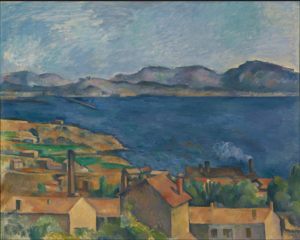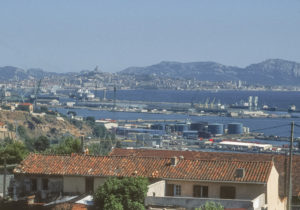R626 – Le Golfe de Marseille vu de l’Estaque, vers 1885 (FWN196)
Pavel Machotka
(Cliquer sur l’image pour l’agrandir)
In Le Golfe de Marseille, vu de l’Estaque, Cézanne takes as his subject the magnificent expanse of the Bay of Marseilles, by itself, with only a narrow foreground to help articulate the space. Taking on so broad and saturated a sheet of color requires a certain obstinate determination. The color itself is not a problem, because an intense blue can play against the saturated yellows and yellow-reds of the houses, but the large surface of the water could easily go flat and appear empty. Cézanne solves the problem simply by varying the blues (with greens and violets) and laying the touches horizontally and densely; this establishes the bay as lively but palpable and solid, and allows the planes of the walls and roofs to articulate with it naturally. To help bridge the near and far shores, he spans the space with an implied line extending between the smoke and the jetty at the Marseilles end, and this imagined diagonal gives us an inclination repeated in the distant hills and in the broad shape of the nearby shore. What remains of the parallel touch in the hills balances this diagonal, by the way. All of these expressions of his craft turn a seemingly placid scene into a painting with discreet tensions. To convince oneself of the way they work, one might try blocking out these elements one at a time, and then one might try obscuring the spot of red at bottom center to see how important it is for holding the composition together.
Adapted from Pavel Machotka, Cézanne: The Eye and the Mind.



